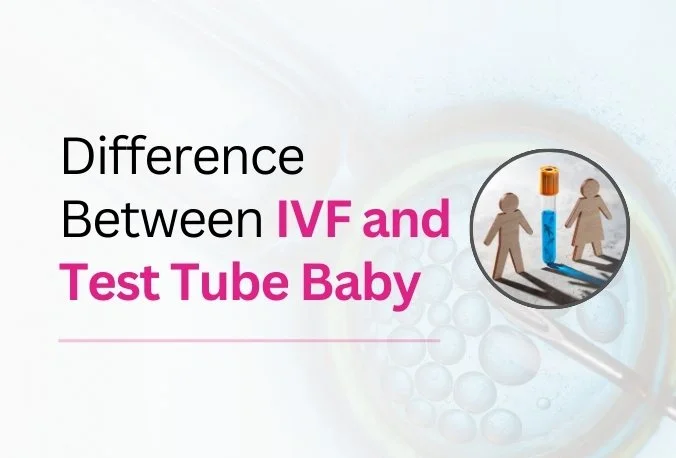Difference between IVF and test tube baby
– Published on 25 APRIL 2024

Fertility treatments have become increasingly vital in today’s society, as a growing number of individuals and couples grapple with various reproductive challenges.
These medical advancements open up new possibilities for parenthood, bringing hope to many struggling with conception. Among these treatments, In Vitro Fertilization (IVF) and the so-called ‘Test Tube Baby’ procedure are two of the most widely recognized and utilized methods.
They have revolutionized the field of reproductive medicine, offering an alternative path to parenthood for those who might otherwise have found it unattainable. With society’s growing awareness and acceptance of diverse pathways to start a family, the demand for these fertility treatments is continually increasing.
Dreaming of parenthood? Pune IVF offers cutting-edge IVF treatments tailored for your needs. Start your journey to a family today with a consultation from our expert team.
In Vitro Fertilization (IVF) and how it works?
In Vitro Fertilization, commonly referred to as IVF, is a complex series of procedures employed to aid fertilization, embryo development, and implantation, hence increasing the likelihood of pregnancy.
The IVF process begins with a course of hormonal therapy to stimulate the ovaries, producing multiple eggs instead of the single one that usually develops each month. These eggs are then retrieved in a minor surgical procedure known as ‘egg retrieval’.
Following retrieval, the eggs are fertilized in a laboratory setting, using sperm that has either been donated or obtained from a partner. The fertilized eggs (now embryos) are monitored for growth over several days.
Once the embryos develop, one or more are selected for transfer into the woman’s uterus, with the hope that they will implant and develop into a successful pregnancy. Any remaining viable embryos can be frozen and stored for future use.
The entire process takes about two weeks, but it may require more than one cycle to achieve a successful pregnancy.
Test Tube Baby Procedure and How It Works?
The term ‘Test Tube Baby’ is often used interchangeably with IVF, as the fundamental process is the same. The term arises from the fact that fertilization occurs outside the body in a laboratory, presumably inside a ‘test tube’, although it’s more likely to happen in a petri dish.
The process involves the collection of mature eggs from a woman’s ovaries, which are then fertilized in the laboratory. The fertilized egg, or zygote, is nurtured into an embryo before being transferred back into the woman’s womb.
Key Differences between IVF and Test Tube Baby
Often, the confusion stems from the fact that the Test Tube Baby process is essentially IVF. However, the term ‘Test Tube Baby’ is largely colloquial and is more commonly used in non-medical discourse. It is a dated term that arose when these procedures were new, and it’s less commonly used by medical professionals today.
Technically, ‘Test Tube Baby’ and IVF refer to the same process: assisted reproductive technology where fertilization happens outside the body.
Therefore, while there may be subtle variations in how different clinics or regions carry out and refer to these procedures, there are no key differences between IVF and Test Tube Baby procedures as they are, in essence, the same thing.
Advantages and Disadvantages, and Comparison of IVF and Test Tube Baby
Success Rates
The success rates of both IVF and Test Tube Baby procedures are very similar, as they are fundamentally the same process. The success can vary greatly depending on factors such as age, cause of infertility, and lifestyle factors. According to the HFEA (Human Fertilisation and Embryology Authority), the approximate success rate is 32.2% for women under 35, and this decreases as the age increases.
Cost Comparison
The cost for IVF and Test Tube Baby procedures are also very similar. Costs can vary greatly depending on your location, the clinic, and whether additional treatment steps are required.
In Pune, the cost of IVF and Test Tube Baby treatments largely depends on individual cases and the fertility clinic chosen. On average, the cost can range from INR 1,00,000 to INR 2,50,000 for each cycle. This includes the doctor’s consultation, ultrasound scans, blood tests, egg pickup, embryo transfer, and medications.
However, it’s important to note that additional treatment steps, if required, may come with extra charges. These costs may fluctuate based on the clinic’s reputation, the complexity of the couple’s case, and the specific requirements of the treatment process.
Advantages
The main advantage of both methods is that they provide an opportunity for parenthood to those who might not be able to conceive naturally. They also allow for genetic screening of embryos, which can be important for those with a risk of passing on genetic conditions.
Disadvantages
The disadvantages of these procedures are also similar. The main ones include the high cost, the potential for multiple pregnancies (which carry risks for both the mother and the babies), and the emotional and physical stress involved in the treatment. The procedures also do not guarantee a successful pregnancy.
In fact, the success rate for both IVF and Test Tube Baby treatments is about 30-35% per cycle. This success rate decreases with age, as fertility declines naturally.
Choosing the Right Fertility Clinic
When selecting a fertility clinic, it’s crucial to conduct thorough research and consider several key factors.
- Expertise and Experience: Look for clinics with a team of experienced and qualified fertility specialists. The doctor’s years of experience, success rates, and areas of specialization can significantly impact the outcome.
- Success Rates: High success rates are indicative of a clinic’s competence and expertise. However, remember to consider the clinic’s patient demographic, as some clinics may only take on less complex cases, skewing their success rates.
- Transparent Cost Structure: Choose a clinic with a clear and transparent cost structure. Be wary of clinics that do not provide a comprehensive breakup of costs upfront.
- Personal Comfort: It’s essential that you feel comfortable with the doctor and the clinic’s staff, as the fertility journey can be emotionally taxing.
- Advanced Technology: Review the technology and facilities available at the clinic. The use of advanced and latest technology can greatly impact the success of the procedure.
- Patient Reviews: Lastly, consider previous patient reviews and testimonials. These can provide valuable insights into the clinic’s practices and patient care standards.
Are you struggling with infertility and seeking compassionate, expert care? Dr. Samidha Dalvi-Amale, a famous IVF specialist in Pimple Saudagar,Pune, is here to help.
Conclusion
Both IVF and Test Tube Baby procedures are viable options for those struggling with infertility. When it comes to choosing between IVF and Test Tube Baby procedures, the decision ultimately depends on individual needs and circumstances. Both methods have proven successful for certain couples, but each has its own set of advantages and disadvantages.
For couples with specific genetic concerns, the possibility of embryo screening offered by these methods may be a significant advantage. However, given the high costs and the emotional and physical toll they can take, it’s important for couples to thoroughly consider their options and seek professional medical advice.
There’s no ‘one-size-fits-all’ solution in fertility treatment. The best approach is usually a personalized one, tailored to the unique needs and circumstances of the couple.

By Dr Samidha Dalvi-Amale
IVF and Fertility specialist Medical Director- Pune IVF
